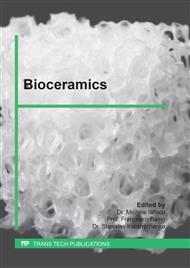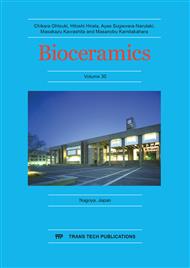[1]
C. Schonauer, E. Tessitore, G. Barbagallo, V. Albanese, A. Moraci, The use of local agents: bone wax, gelatin, collagen, oxidized cellulose, Eur. Spine J. 13 (Suppl. 1) (2004) S89–S96.
DOI: 10.1007/s00586-004-0727-z
Google Scholar
[2]
C. Hama, T. Umeda, Y. Musha, S. Koda, K. Itatani, Preparation of novel hemostatic material containing spherical porous hydroxyapatite/alginate granules, J. Ceram. Soc. Japan. 118 (2010) 446-450.
DOI: 10.2109/jcersj2.118.446
Google Scholar
[3]
D. Yamashita, T. Umeda, Y. Musha, S. Koda, K. Itatani, Fabrication of Flexible Porous Whisker-Like Hydroxyapatite/Alginate Composite, J. Soc. Inorg. Mater. Japan.18 (2011)3-9.
Google Scholar
[4]
E. Shima, T. Umeda, Y. Musha and K. Itatani, Properties of novel bone hemostat by random co-polymer of ethylene oxide and propylene oxide with sugar-containing hydroxyapatite, Adv. Mater. Lett. 7 (2016) 90-94.
DOI: 10.5185/amlett.2016.6132
Google Scholar
[5]
T. Mimura, T. Umeda, Y. Musha, K. Itatani, Properties of novel bone hemostat prepared using hydroxyapatite, phosphoryl oligosaccharides of calcium and thermoplastic resin, J. Ceram. Soc. Japan. 121(2013) 68-73.
DOI: 10.2109/jcersj2.121.68
Google Scholar
[6]
T. Mimira, T. Umeda, Y. Musha, K. Itatani, Properties of novel bone hemostat prepared using sugar-modified hydroxyapatite, phosphoryl oligosaccharides of calcium and thermoplastic resin, Mater. Sci. Eng. 47(2013) 012008.
DOI: 10.1088/1757-899x/47/1/012008
Google Scholar
[7]
K. Y. Lee, D. J. Mooney, Alginate: properties and biomedical applications, Prog. Polym. Sci. 37 (2012)106–126.
Google Scholar
[8]
Y. Okita, S. Fujisawa, T. Saito, A. Isogai, TEMPO-oxidized cellulose nanofibrils dispersed in organic solvents, Biomacromolec. 12(2011)518–522.
DOI: 10.1021/bm101255x
Google Scholar
[9]
H. Sambe, K. Sugimoto, K. Nomura, T. Kuriki, Effects of phosphoryl oligosaccharides of calcium (POs-Ca) on epidermal cells and human skin, J. Appl. Glycosci. 62(2015)107‒113.
DOI: 10.5458/jag.jag.jag-2015_002
Google Scholar
[10]
T. Umeda, K. Itatani, H. Mochizuki, Properties of calcium phosphate powder prepared from phosphoryl oligosaccharides of calcium, Key Eng. Mater. 309/311(2006)515-518.
DOI: 10.4028/www.scientific.net/kem.309-311.515
Google Scholar
[11]
L. Wang, G. H. Nancollas, Calcium orthophosphates: crystallization and dissolution, Chem. Rev. 108(2008)4628–4669.
DOI: 10.1021/cr0782574
Google Scholar
[12]
M. Wang, C. Shao, S. Zhou, J. Yang, F. Xu, Preparation of carbon aerogels from TEMPO- oxidized cellulose nanofibers for organic solvents absorption, RSC Adv. 7(2017)38220.
DOI: 10.1039/c7ra05506d
Google Scholar
[13]
N. Yin, S. Chen, Y. Ouyang, L. Tang, J. Yang, H. Wang, Biomimetic mineralization synthesis of hydroxyapatite bacterial cellulose nanocomposites, Prog. Natur. Sci.: Mater. Int. 21(2011) 472−477.
DOI: 10.1016/s1002-0071(12)60085-9
Google Scholar
[14]
W. Yang, H. Bian, L. Jiao, W. Wu, Y. Deng, H. Dai, High wet-strength, thermally stable and transparent TEMPO-oxidized cellulose nanofibril film via cross-linking with poly-amide epichlorohydrin resin, RSC Adv. 7(2017)31567.
DOI: 10.1039/c7ra05009g
Google Scholar
[15]
S. Koutsopoulos, Synthesis and characterization of hydroxyapatite crystals: A review study on the analytical methods, J. Biomed. Mater. Res. 62(2002)600–612.
DOI: 10.1002/jbm.10280
Google Scholar
[16]
N. Lavoine, J. Bras, T. Saito, A. Isogai, Improvement of the thermal stability of TEMPO-oxidized cellulose Nanofi brils by heat-induced conversion of ionic bonds to amide bonds, Macromol. Rapid Commun. 37(2016)1033−1039.
DOI: 10.1002/marc.201600186
Google Scholar
[17]
H. Dong, J. F. Snyder, K. S. Williams, J. W. Andzelm, Cation-Induced Hydrogels of Cellulose Nanofibrils with Tunable Moduli, Biomacromolec. 14 (2013)3338−3345.
DOI: 10.1021/bm400993f
Google Scholar



